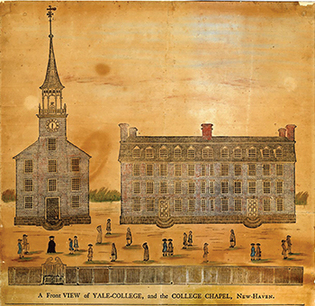 loading
loading
Old YaleRemembrance of plagues pastClasses at Yale were interrupted by epidemics long before the arrival of COVID-19. Judith Ann Schiff is chief research archivist at the Yale University Library.  In this 1786 woodcut of Yale by Daniel Bowen, students near President Ezra Stiles (at left, in black) take off their hats—a time-honored tradition in that era. View full imageYale classes have been disrupted by war, weather, labor actions, and epidemics over the university’s 320-year history—particularly in the eighteenth century, when the fear of “pestilential distempers” forced Yale presidents to “break up” the college at critical times. Our best record of epidemics in that era was written by Ezra Stiles ’46, president of Yale from 1778 to 1795, in his Literary Diary (edited and published in 1901). Stiles meticulously documented the fevers and plagues that swept through New Haven during his presidency, especially the scarlet and yellow fevers that terrorized the college toward the end of his life. It was early in 1794 that scarlet fever broke out. Stiles noted on February 10 that the town was “alarmed with Danger of the Spreading of the canker or ulcerous sore Throat or scarlet fever.” On March 15, “Backus, a Freshman” died, having “taken sick” the day before. Ten days later: “a Freshm. Sick. College alarmed. Three Classes petition Dismission. Declined.” The next day: “four scholars sick with Scarletina fever. On the 29th: “The students unusually alarmed & agitated, so that I dismissed about Twenty.” On the 31st: “I myself & wife taken sick. We released as many scholars to go home as intimidated. Abot Two Thirds to day.” On April 2, Stiles “discontinued all College Exercises till May Vaca or till College shd be called together by Advertisement.” He and the tutors, he wrote, “design to Tarry in To[wn]. I notified them that those who tarried might recite daily & receive the necessary instruction.” In April, the epidemic abated, and the college reopened fully on May 27 at the end of vacation. Then, just three months later, another plague swept through New Haven. In August, Stiles noted that “The yellow fever brot in by a Vessel here about 15 or 16 June last, which has been lurkg about ever since & now proves dreadful. Sixteen or 18 deaths out of Twenty patients at least. More mortal than the small pox, tho less contagious.” Scarlet fever, “tho’ much abated” was “yet extant.” Only about half of the students returned for the summer term. On September 5, Stiles wrote about issues that sound familiar 235 years later: contact tracing and social distancing. “Hitherto I have believed that by the care & vigilance of the Authy [Authorities], it might be guarded & its progress checked, as we could hitherto, trace all the Instances; but now they begin to be lost and bewildered. I begin to give up the possibility of preventg its spreadg, and to be discouraged and to wish my fam[il]y out of town. This forenoon I sent off my Eliza to the farms.” After a public Commencement on September 10, students were told not to return until November 12. The yellow fever epidemic ended on October 28, according to Stiles’s account. On New Year’s Day 1795—five months before he himself would die of a “bilious fever”—Stiles wrote a “Bill of Morty for New Haven The Year 1794.” It was based on his special notebook of daily statistics on the epidemics. Out of a population of about 3,500, 50 had died of scarlet fever, 63 of yellow fever (87 had recovered from it), and 78 either of other sicknesses or because they had “died at sea.” The data collected by Stiles and New Haven County physicians led to the founding of the city’s first board of health in April 1795. They were also used by Noah Webster ’78 in his pioneering 1799 work A Brief History of Epidemic and Pestilential Diseases. The book became a standard text in early medical schools.
The comment period has expired.
|
|